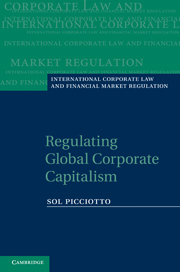Book contents
- Frontmatter
- Contents
- Preface
- Acknowledgements
- Table of cases
- Abbreviations and acronyms
- 1 Transformations of global governance
- 2 Liberal internationalism: strengths and limits
- 3 From interdependence to fragmentation
- 4 Corporations and competition
- 5 Corporate rights and responsibilities
- 6 International taxation
- 7 Regulation of international finance
- 8 The WTO as a node of global governance
- 9 Intellectual property rights
- 10 Law and legitimacy in networked governance
- Bibliography
- Index
5 - Corporate rights and responsibilities
Published online by Cambridge University Press: 05 June 2012
- Frontmatter
- Contents
- Preface
- Acknowledgements
- Table of cases
- Abbreviations and acronyms
- 1 Transformations of global governance
- 2 Liberal internationalism: strengths and limits
- 3 From interdependence to fragmentation
- 4 Corporations and competition
- 5 Corporate rights and responsibilities
- 6 International taxation
- 7 Regulation of international finance
- 8 The WTO as a node of global governance
- 9 Intellectual property rights
- 10 Law and legitimacy in networked governance
- Bibliography
- Index
Summary
The rapid international expansion of corporations in the second half of the twentieth century led to an intriguing double movement in the forms of business regulation. The dominant trend has been to facilitate that expansion, by liberalization of national controls on investment capital flows, accompanied by measures to strengthen international legal protection of the rights of owners of such investments. However, this has been counterpointed by a growth of regulation, both by home and host states, and increasingly through international regulatory networks.
This double movement took place in two phases. In the first, from the early 1950s to 1980, the liberalization of capital controls was gradual. This helped to pave the way for the renewed expansion of TNCs mainly from the USA and a few other capital-exporting states such as the UK, the Netherlands, France and Switzerland, and their home states also sought to strengthen the international legal protection of their foreign assets. However, this expansion quickly produced a reaction, both from host countries fearful of the effects of foreign economic domination, and from their own home countries (especially the USA), extending regulation to their foreign affiliates. Thus, TNCs found themselves subject to regulation by host and also home countries, which sometimes conflicted.
Amid considerable debate about how to treat these new ‘world citizens’, the main international response was a move to draw up codes of conduct.
- Type
- Chapter
- Information
- Regulating Global Corporate Capitalism , pp. 155 - 206Publisher: Cambridge University PressPrint publication year: 2011



